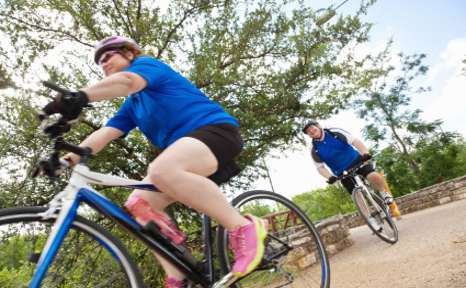

Strength training and low-impact cardio can help your joints

For patients who have osteoarthritis of the knee, exercise can be one of the most important parts of treatment. Why? First, exercise plays a vital role in weight loss, which can help relieve unnecessary and pain-inducing strain on the knees and joint. Second, exercise helps strengthen the thigh and lower leg muscles around the knee. This added joint support, will increase stability, range of motion and function and also decrease stiffness and pain. Exercise also prevents the joints from freezing up and promotes endurance.
Even a small amount of weight loss can provide noticeable relief for knee pain. In addition to a balanced diet high in anti-inflammatory foods, exercise is the other half of the weight-loss equation. Remember to apply heat before exercise and cold packs afterward to help relieve and prevent pain and inflammation.
It is important to check with your doctor before starting any type of exercise routine. After you get your doctor’s approval, you can try some of these types of exercises to help with osteoarthritis of the knee:
Strength, or resistance, training has been in many cases shown to slow both the progression of OAK and overall loss of lower-body strength. You will use either light weights or your body weight to perform the exercises below. For illustration on how to perform these exercises, see here.
Wall squats: Slide down while leaning your back against a wall, hold a bent-knee position for five seconds, then slide back up. Repeat 8-12 times.
Leg curls: With a lightweight (3-5 lbs) attached to or wrapped around your leg just above your ankle, place your hands on the back of a chair for balance and support. Bend your weighted leg up toward you buttocks, pause at the top, then slowly lower back down. Repeat 8-12 times before switching to the other leg.
Wall pushups: Standing about 2 feet away, place your hands flat on a wall. Bend you elbow, lean forward, supporting your weight with your arms. Hold the position for 3-5 second, then slowly push yourself back to the starting position. Repeat 8-12 times.
It’s a good idea to partner strength-training exercises with some low-impact cardio. For those with osteoarthritis of the knee, regular aerobic exercise can reduce pain, improve function and build strength. Plus, it’s necessary to help with weight loss and weigh management. Here are some options for low-impact, knee-friendly exercises:
Swimming
Swimming is great for knee-pain suffers because the natural buoyancy of the water supports part of your weight, reducing stress on your joints. At the same time, working out in water provides plenty of resistance. The faster you swim, the harder your heart pumps. Beware of knee-busting actions, though, like pushing off from the wall too hard on turns. If swimming isn’t your thing, you can gain similar resistance and cardio benefits from water aerobics.
Cycling
Biking is another good choice for OAK patients because cycling regularly keeps knees using a range of motion at the same time it strengthens muscles that support the knees. However, there are some considerations to keep in mind. If while riding you experience pain, stop. If you have pain or balance problems, you might want to switch from biking outdoors to riding a stationary bike.
Tai Chi
The traditional Chinese martial art of Tai Chi has been found to reduce pain and improve knee function for patients over age 65 who suffer from osteoarthritis. The art’s slow, rhythmic movements are relaxing, but also enhance muscle strength, balance and flexibility. There’s a minimal risk of injury and no equipment is needed, so anyone at any level can start practicing.
Copyright © www.orthopaedics.win Bone Health All Rights Reserved